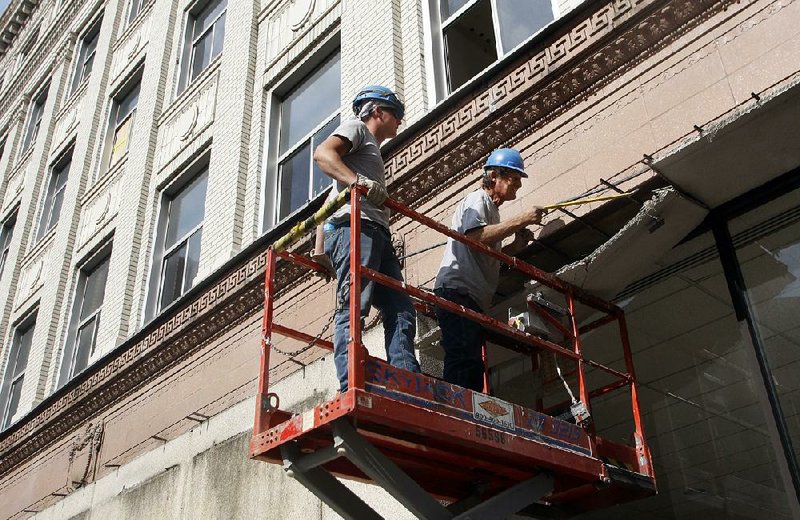A $3 purchase on eBay could save the developers of the Capitol Lofts $300,000.
Or so David Robinson ballparks it.
Robinson Googled the Hall Building and found a circa 1962 news photo of the aftermath of a fire at the building.
The photo tantalizingly showed the original facade on the Louisiana Street side of the 1923 building. So Robinson had someone uncover a tiny part of the old architecture, a shield, just as in the photo.
That motivated Robinson to have some of the “modern” aggregate removed from the southeast corner of the building to the northeast corner.
Eureka!
The reddish band of terra cotta with classical motifs wraps the entire first floor of the building, including the Capitol Avenue side.
Though Delta Capital Partners, the group redoing the Hall, had found photos of the building in its early years, they “didn’t know what was demo-ed in the ’70s” to make room for the panels. So off came the plain veneer.
Robinson used a word to describe the panels made of aggregate, each weighing 5 to 10 tons each: Brutalist.
New to me. I didn’t recall that from the art history course I took in college. Architecture in that class concentrated on the classics — Roman, Athenian and Egyptian, with their mathematical precision and slews of gods — and a smattering of the modern.
I turned to one of the flawed deities of modernity, Google, and found out that the Brutalist school of architecture is an offshoot of the International style. ( No, Google is not perfect; even I once stumped it.)
Brutalism is meant to convey fortress-like strength.
Across the street from the Hall Building is an outpost of the Bank of America, looking the way you might want your bank to look, like a fortress.
After all, where is the U.S. government gold depository? Fort Knox.
OK. Brutalism. A highbrow international postwar reaction to the virtual destruction of Europe in order to rid it of Hitler, and to the nuclear obliteration of Hiroshima and Nagasaki to bring the war to an end and prevent a murderous invasion of fortress Japan by U.S. troops. We get it already.
We also get that the “modern” style in general has more to do with utilitarianism. Details cost money. Construction companies that do ambitious projects are always hurting for artisans.
(Redevelopers of historical buildings have budgets, of course. Since the Hall Building and its three-story annex, the Davidson Building, are in the Capitol-Main Historic District, they can qualify for generous state and federal income tax credits based on the amount spent on construction. Thus, in this case, the big payoff on the $3 bet.)
Lumped in with the purveyors of Brutalism is Moshe Safdie, who designed, of all things, the Crystal Bridges Museum of American Art.
My wife and I made it to Bentonville to take in the state’s crown jewel of art museums. There was a video presentation about the man who designed the museum.
I was disappointed that the film was not about his efforts on Crystal Bridges. It was a review of his career, a portfolio of his international projects.
In that retrospective was Habitat 67, a Legolike-block design of one cube after another — on top, beside, inset — looking like the cliff dwellings of the Pueblo Indians.
Safdie’s vision has fared well in the nearly half-century of its existence. And, for a traditionalist such as me, it has a certain appeal.
The very name Crystal Bridges seems anathema to Brutalism. It sounds fine and fragile. As the title of Tennessee Williams’ play The Glass Menagerie is intended to convey.
So maybe it is wrong to categorize it so crudely, so brutishly.
Speaking of attempts to categorize, Robinson, Josh Blevins, a partnership investor, and this columnist were standing on the corner, looking up at the Hall Building and musing over its architectural style. This scribbler averred, with equal parts bluff and knowledge, that it is Italianate. After all, write it often enough and no one questions.
Beaux-arts (French for fine arts) was offered.
Google it, but that’s too fine, grand and Gallic for this five-story building.
Italianate fits the Hall, just as it does the Boyle Building, its older and bigger sibling one block east on Capitol.
Designed by George R. Mann, the dominant architect of that era in Little Rock (who was a devotee of the father of the skyscraper, Louis Sullivan of Chicago), the Boyle predates the Hall by 14 years and no doubt influenced its look, although it was designed by two other Little Rock architects, Theodore M. Sanders and Frank Ginocchio who evidently were in turn devotees of Mann.
If you have a tip, call Jack Weatherly at (501) 378-3518 or email him at
jweatherly@arkansasonline.com
